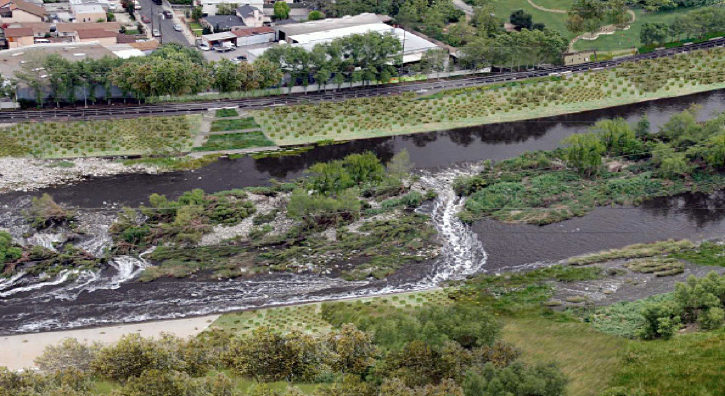CommentsLA WATCHDOG--In 2013, Mayor Eric Garcetti told us that the revitalization of the 11 mile stretch of the Los Angeles River from Griffith Park to the Arts District was projected to cost $1.1 billion, of which the City’s share was $432 million.
In 2015, the cost increased to $1.4 billion, but our share for the 11 mile revitalization ballooned to $1.2 billion as federal regulations limited the Army Corps of Engineers contribution to $200-$300 million. While the City had no clue how it was going to come up with its share, the City Council authorized the City Administrative Officer to issue a letter to Army Corps of Engineers stating the City will have the financial capability to meet its cost sharing obligations.
In late 2016, the revitalization plan was expanded to include the first 32 miles of the 51 mile long Los Angeles River that flow through the City, beginning in Canoga Park and ending at the Vernon line. But once again, the cost ballooned, this time to an estimated $7 billion. The cost per mile also increased to $219 million, up 72% from the $127 million per mile for the 11 mile revitalization plan.
Importantly, EIFDs are not permitted to fund operating expenses such as ongoing maintenance and repairs, adding another level of expense to the river revitalization plan that has not been considered.
Consistent with past practice, Garcetti has not developed a plan to finance this aspirational, multi-decade project. However, one alternative that is being considered by the City Council and the Economic and Workforce Development Department (“EWDD”) is Enhanced Infrastructure Financing Districts (“EIFD”), a new financing vehicle authorized by the State in 2015 that allows local governments to fund capital projects by diverting “incremental” property tax revenues from the City to an EIFD to finance the payment of interest and principal on long term bonds.
In many ways, EIFDs are intended to replace the controversial and often corrupt Community Redevelopment Agencies by limiting their taxing authority to ‘consenting” entities (in this case the City and County, but not LAUSD) and requiring a 55% vote of the EIFD voters to approve the issuance of bonds.
The recent report prepared at the request of EWDD recommends establishing nine EIFDs along the 32 miles of the river that would be entitled to collect 75% of the incremental property taxes from properties within one mile of the River due to the City and County (52% of the total as any incremental tax revenues due LAUSD would not be included) that exceed the existing assessed value. This amount would then be reduced by interest payments, interest reserves, and delinquency reserves. And then another 20% would be set aside for affordable housing.
Over the next 30 years, the report indicated (but only after massaging the massive amounts of data) that over $7.6 million in incremental tax revenues would be available to the nine river EIFDs. But after financing costs (interest, interest coverage, and reserves) and the affordable housing set aside, only $1.5 billion (20%) is available for investment in river related projects. This is an unacceptable proposition that is dependent on issuing massive amounts of debt.
The report also indicates that the EIFDs will not increase taxes of the properties in the district. While true, it will divert the incremental property tax revenue from the City’s General Fund, resulting in less money for services for those who live in the remaining 88% of the City based on the assessed value of all City property. Again, this is not an acceptable proposition since the City’s voters do not have a say in the matter.
There are also issues of transparency and accountability that need to be addressed as the EFIDs may have a life span of up to 45 years and may have the ability to increase fees and assessments without the approval of the voters in the districts or the City.
What is not to like about a revitalized Los Angeles River? But does the river revitalization plan take priority over repairing our lunar cratered streets, our parks, and our urban forest; public safety (LAPD and LAFD); affordable housing and the homeless; and the restoration of City services. And should the City develop a pay as you go revitalization plan instead of issuing billions in new debt?
Before proceeding with the $7 billion river revitalization plan and the establishment of EIFDs, the City needs to reach out to the entire City and its Neighborhood Councils to determine the City’s priorities and educate the public on the revitalization plan and the intricacies of the Enhanced Infrastructure Financing Districts.
(Jack Humphreville writes LA Watchdog for CityWatch. He is the President of the DWP Advocacy Committee and is the Budget and DWP representative for the Greater Wilshire Neighborhood Council. He is a Neighborhood Council Budget Advocate. Jack is affiliated with Recycler Classifieds -- www.recycler.com. He can be reached at: [email protected].)
-cw
Sidebar

 CityWatch Los Angeles
Politics. Perspective. Participation.
CityWatch Los Angeles
Politics. Perspective. Participation.

18
Thu, Apr













